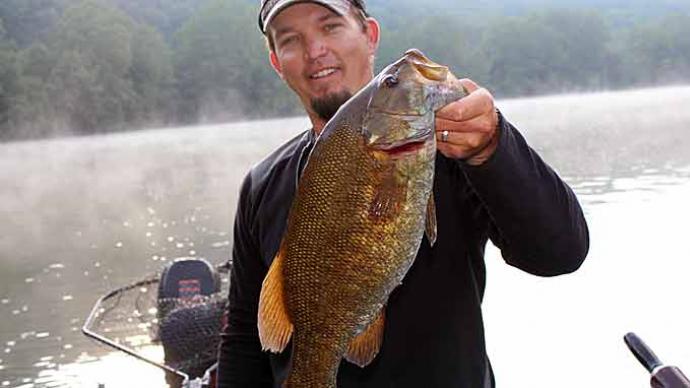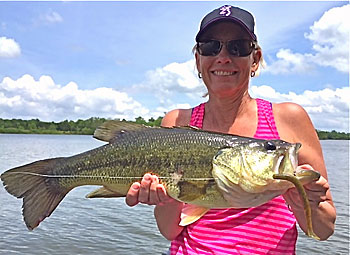
You drive by them every day; the roadside gravel pit, the little lake in the city park, the ponds on the golf course, a modest puddle in the far reaches of the state park. Small, inconsequential bodies of water, right? There can’t be any big bass in those. Wrong!
Small ponds and lakes are usually extraordinarily fertile and provide a bounty of terrestrial and aquatic prey for resident bass. While the mere size of these bodies of water would seem to dictate they’re not capable of producing trophy bass, nothing could be farther from the truth. Bass in small places can attain a ripe old age because they see relatively little fishing pressure. Some neighborhood kids might fish them from the banks or a family that throws out some bobbers for panfish, but few serious bass zealots fish them.
My friend Dave Jerome and his girlfriend, Stacy Vobach, catch some lunker largemouths from ponds and small lakes near their home in Kansas. Bass nirvana like these can be found all across the country. The key is access and fishing where others don’t.
Some type of watercraft is essential. It allows you to cast from out in deeper water and fish the shoreline, opposite what everyone else does. It can be a two-man bass tub, a personnel pontoon, a float tube, or a kayak. The watercraft must be portable because you won’t be able to drive right up to the water, and you may have to drag or carry the watercraft a fair distance. Once you’re on the water, though, the fishing is relatively simple.
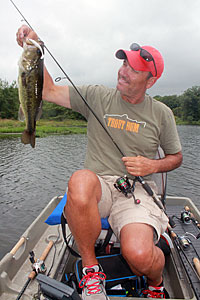
“I’ve got a 12-volt trolling motor on my two-man bass tub, and we just work around the lake casting to the edges or maybe the first drop off,” Jerome said. “My top two baits for bass are a Gary Yamamoto 5" Swim Senko green pumpkin/black flake and Zoom Swimming Super Fluke Jr. white pearl. I fish them both on a 3/0 wide bend hook with no weight, close to shore next to weeds, and swim the lure with short foot to 2-foot twitches. Another proven bait is a 7-inch Berkley Power Worm in green pumpkin, black, and purple. I also use a Texas-rigged Yum Crawbug (watermelon) near rocks and rig a watermelon and red flake Yum Dinger wacky-style when things get tough, which they rarely do. It seems these pond fish are always hungry.”
“I fish mainly with a medium-action spinning rod with 8-lb mono,” he said. “I have not tried super line, but maybe I should. I use a medium-action bait-casting outfit when throwing crankbaits and weighted soft baits.”
In most cases, pond bass are not picky because they have such a diverse forage menu from which to choose. Bass lie, waiting for terrestrial creatures to venture into the water intentionally or accidentally. The buffet runs the gambit from ducklings, snakes, and mice to frogs, grasshoppers, and birds. Anything a bucketmouth can swallow becomes dinner.
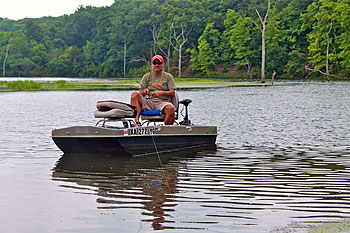
Two species that small-water bass do key on are bluegills and crayfish. Unlike large reservoirs and lakes, small bodies of water generally don’t have shad. About the only baitfish in these ponds and lakes have are bluegills. Bluegills become the dominant prey in the summertime when they suspend over the deep water to feed on microscopic organisms away from the weeds in these shallow eutrophic lakes. You can often see them dimpling the surface of the water. Bass will suspend under the bluegills and partake in the buffet. It’s about the only time you find the better fishing in the middle of the lake and not along the shorelines. Watch for the dimpling schools of bluegills and the explosions that indicate that bass are keying on them.
Jerome said he switches to crankbaits when that happens. “The crankbaits that I use are on the small side to imitate the young-of-the-year panfish,” he said. “They’ll run 0 - 3 feet. The Bomber Square A in Baby Bass, Foxy Shad, Fire Tiger, and Apple Red Crawdad finishes are killer. I also use a Model 6A Bomber in Tennessee Shad that runs down to 8 feet when they are offshore in the lake's deepest water.”
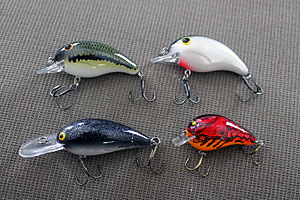
Finding bass in small lakes and ponds is not tricky. The sheer size of these bodies of water makes it easier, but you can still make use of a good graph to pinpoint drop-offs and the deepest water in the lake. The structure is magnified on these lakes because there’s less of it. On an enormous reservoir with a high-powered bass boat, you can run and gun from one end of the lake to the other, but on small ponds, you want to be deliberate and fish slowly and quietly as possible. The best fishing typically occurs after a prolonged stretch of stable weather with light winds. Early and late are usually the best times to fish, but midday can be super productive early and late in the season. These smaller lakes and ponds warm up and cool down quicker than larger bodies of water, so hot fishing can occur well before things pick up on nearby larger lakes and reservoirs.
Stickups, laydowns, stumps, dead trees, and over-hanging branches are good spots to target wherever you fish for bass, but they can be exceptional on small lakes when there are so few of them. A prime piece of structure will often hold multiple bass and the biggest bucketmouth in the pond. Weeds, both submergent and emergent, are always primary spots to begin your search on small waters.
Because you can travel light, don’t be committed to one body of water. Pond hopping and being mobile is one advantage the minimalist angler has. You can throw your watercraft of choice in the back of the truck and head to a new body of water. It often pays to backtrack around the same shoreline with a different lure if you know big bass are present.



